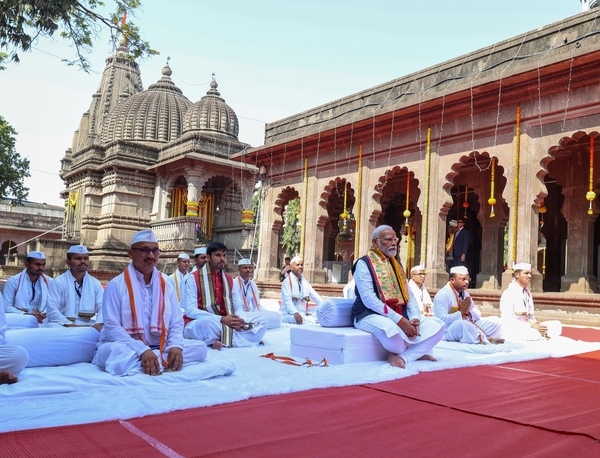PM Modi's visit to Kala Ram Mandir: Say Bye-Bye to Caste Discrimination!
12 Jan 2024 16:47:47
Prime Minister Narendra Modi has sent a strong social message by beginning a special `anushthan’ from Nashik, which has special significance in the life of Prabhu Ramchandra. Several major incidents, like abduction of Sita by Ravana, took place in this holy city. But in addition to this, Nashik has importance for some other reason in the fight for social equality and eradication of the caste system.
Narendra Modi visited Kala Ram Mandir in Nashik, where people of deprived class launched an agitation in March 1930. The agitation was to demand entry for depressed-class people in the temple. Dr Ambedkar himself led the agitation as the temple entry was restricted only to few castes.
Narendra Modi visited Kala Ram Mandir in Nashik, where people of deprived class launched an agitation in March 1930. The agitation was to demand entry for depressed-class people in the temple. Dr Ambedkar himself led the agitation as the temple entry was restricted only to few castes.

After making efforts for almost three months, Dr Ambedkar launched the agitation, which continued for five years. Around 15,000 people participated in the agitation. They used to sing bhajans outside the temple. However, the agitation was opposed by orthodox people because of this it prolonged for five years. The gates of Kala Ram temple were finally opened for depressed class people after a prolonged struggle.
Dr Ambedkar launched the agitation to assert equality as so-called untouchables were prohibited from entering in any temple. Modi’s visit to Kala Ram Mandir assumes significance in the backdrop of the consecration ceremony of Ram Janma Bhoomi Mandir. All of us must remember that ‘sanyas’ of Ram Janma Bhoomi Mandir in Ayodhya was performed by Kameshwar Chaupal, who belongs to a scheduled caste. Chaupal is also one of the trustees of Shri Ram Janma Bhoomi Tirth Kshetra, which is involved in the construction of the temple.
At the Shree Kalaram Temple, I had the profound experience of hearing verses from the Bhavarth Ramayana written in Marathi by Sant Eknath Ji, eloquently narrating Prabhu Shri Ram's triumphant return to Ayodhya. This recitation, resonating with devotion and history, was a very… pic.twitter.com/rYqf5YR5qu
— Narendra Modi (@narendramodi) January 12, 2024
Modi’s visit to Kala Ram Mandir signifies, how Hindus are moving ahead to eradicate caste discrimination. It was 94 years back when Dr Ambedkar launched agitation at Kala Ram Mandir for entry of depressed class people. Today Modi launched ‘anushthan’ from Nashik and visited Kala Ram Mandir, where Dr Ambedkar launched agitation for temple entry. This indicates that Hindus no more believe in caste discrimination and is committed to the principle of equality.
‘Shilanyas’ by Kameshwar Chaupal underlines the fact that Hindus have marched far ahead on the path of equality and social cohesiveness. Even though the Ram Janma Bhoomi agitation has a history of five centuries, it gained momentum four decades back. The massive agitation would not have been possible without Hindu unity. And the Hindu unity would not have been possible without giving up caste sensitivities.
The biggest achievement of the Ram Janma Bhoomi agitation is Hindu unity. The agitation accelerated the self-correction exercise by Hindus wherein all the Hindus are equal and stay with a deep sense of fraternity. Pertinent to note that Hindu unity is not a temporary phenomenon but it is increasingly gaining momentum as Hindus have changed their traditional attitude and are ready to embrace equality. One may recall Samarasta Yatra, which began in 2005 from Kala Ram Mandir. This was an initiative by Samajik Samarasta Manch.
नासिक के कालाराम मंदिर परिसर की सफाई कर प्रधानमंत्री श्री @narendramodi ने मंदिर व तीर्थक्षेत्रों की सफाई के लिए लोगों को प्रेरित किया।
— BJP (@BJP4India) January 12, 2024
आइए, इस स्वच्छता अभियान में बढ़-चढ़ कर हिस्सा लें और रामलला के आगमन से पहले देशभर के मंदिरों व तीर्थक्षेत्रों को स्वच्छ बनाएं। pic.twitter.com/65DmSnJnoY
This yatra later proceeded in all the directions of Maharashtra, spreading the message of samarasta. The then RSS general secretary Mohan Ji Bhagwat was also present when yatra unfolded its way. Interestingly, Sudhir Das Maharaj, mahant of Kala Ram temple said on the occasion that his grandfather (Ramdas Maharaj) committed a mistake by denying entry to the depressed class. Sudhir Das went on to say that he was ready for atonement for the mistake, committed by his grandfather. Modi’s visit to Kala Ram temple is the extension of the sense of samarasta, which does not have any place for discrimination.
Around five decades back, it was a usual scene to watch a board in all the hotels, declaring that entry to all Indian citizens, irrespective of their caste, creed, religion, language and sex, is free. This board is not seen today as discrimination based on any of these grounds has vanished over time. This board has become part of history. We can experience that caste discrimination is all set to be part of history. Modi’s visit to Kala Ram Mandir reminds us of the past, which saw Dr Ambedkar’s struggle. But Modi’s visit to Kala Ram Mandir against the backdrop of the consecration ceremony in Ayodhya indicates the journey of Hindus on the path of equality. In 94 years, Hindus have marched far ahead and Ram Janma Bhoomi temple has emerged as the greatest symbol of Hindu unity, sans caste discrimination.
